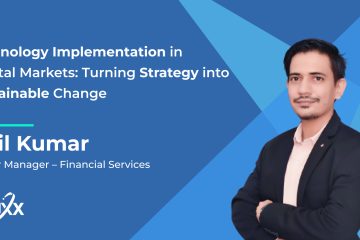The capital markets industry is facing disruptions from ongoing regulatory changes, higher interest rates, and geopolitical tensions, among other things. In 2023, the SEC has reported a 15% increase in enforcement actions, while FINRA has seen a 20% rise in fines related to trading practices; highlighting increased regulatory scrutiny.
To stay relevant and part of this competitive ecosystem, capital markets firms need to take a strategic, long-term approach to business and technology decisions even as the dynamics of market structure and technology investments continue to evolve. Therefore, understanding key technology trends is crucial to staying prepared for the transformative change that awaits.
In this blog, we identify 5 key trends that firms should monitor closely.

This makes it clear that the capital markets industry is facing disruptions from ongoing regulatory changes, higher interest rates, and geopolitical tensions, among other things. Capital markets firms need to take a strategic, long-term approach to business and technology decisions even as the dynamics of market structure and technology investments continue to evolve. Therefore, understanding key technology trends is crucial to staying prepared for the transformative change that awaits.
In this blog, we identify 5 key trends that firms should monitor closely.
1. AI’s Memo: Get on Board or Get Left Behind
There, we said it. AI is here to stay. A 2021 McKinsey report highlights that AI could deliver up to $1 trillion of additional value annually to the global banking sector. AI-driven predictive analytics enable firms to anticipate market movements and optimize trading decisions. An April 2024 report by Gartner notes that by 2025, 75% of large enterprises will adopt AI to streamline operations and improve customer service.
In addition, AI is significantly reducing operational costs. AI’s ability to process vast datasets in real time enhances risk management by identifying potential market risks and compliance issues swiftly. This capability is particularly crucial as the global regulatory landscape becomes increasingly complex and challenging to navigate. Here are some other aspects where AI can be leveraged to deliver improved efficiency.
Customer service
AI-powered chatbots are transforming customer service in capital markets, offering personalized assistance and streamlining client interactions. Even before the age of AI dominating headlines, JPMorgan Chase had implemented COIN (Contract Intelligence), an AI-powered program that reviews legal documents and helps the bank save over 360,000 hours of labor annually. While not a traditional customer service chatbot, COIN’s success demonstrates the potential of AI in automating complex tasks, which can be extended to customer service in capital markets.
Portfolio management
Robo-advisors, which utilize AI algorithms, are gaining traction for their ability to provide tailored investment advice at lower costs. According to Statista, assets under management (AUM) by robo-advisors are expected to reach $1.4 trillion by 2025, reflecting growing investor confidence in AI-driven financial planning.
2. Blockchain and Distributed Ledger Technology: A Much-needed Upgrade
Broadridge’s Distributed Ledger Repo (DLR) platform uses blockchain to streamline the repo market, reducing operational complexities and risks. The DLR platform has been piloted with major banks such as HSBC and other financial institutions, demonstrating its capability to automate collateral management and improve the overall efficiency of repo transactions. By migrating each step of the repo process, involving securities purchased with a third-party agreement for repurchase, to the shared ledger, Broadridge saves clients $1 million for every 100,000 transactions.
Currently, the Swiss Digital Exchange (SDX) uses blockchain to tokenize traditional securities, allowing for fractional ownership and greater liquidity. SDX has conducted successful pilots with various asset classes, proving that tokenization can unlock new investment opportunities and democratize access to capital markets.
Trade settlement
One of the most promising uses of blockchain in capital markets is in trade settlement. Traditional trade settlements can take days, but blockchain can reduce this to near real-time, cutting down counterparty risk and freeing up capital.
Regulatory reporting
By offering real-time auditability, blockchain can help firms with improved compliance, thereby reducing the risk of fines. The Inthanon-LionRock project by the Hong Kong Monetary Authority (HKMA) and the Bank of Thailand is a case in point as to how blockchain can improve cross-border fund transfers and regulatory reporting. This project has shown that real-time data availability can significantly enhance regulatory oversight.
Decentralized finance (DeFi) platforms are also gaining traction, offering alternative financial services that operate outside traditional banking systems, further democratizing access to capital markets.
3. Cloud and SaaS Solutions: The Modern Capital Markets Toolkit
A key driver shaping the infrastructure of capital markets, cloud computing is poised to evolve further to offer scalable, flexible, and cost-effective solutions. From trading desks to compliance teams, firms are adopting cloud-based tools to streamline processes, even as the next frontier is the growing prominence of SaaS platforms.
By leveraging cloud infrastructure, SaaS solutions can help firms scale resources on-demand, avoiding the hefty upfront investments associated with traditional on-premises solutions. This flexibility is particularly crucial during periods of market volatility or regulatory changes.
For example, hedge funds like Two Sigma leverage cloud-based data lakes to ingest, store, and process petabytes of market data daily. By utilizing cloud-based data warehouses and analytics tools, firms can parse structured and unstructured data with ease, extracting actionable insights and gaining a competitive edge in trading and investment strategies.
4. Big Data: The Critical Pillar for Capital Markets Leaders
The rise of cryptocurrencies and other alternative asset classes has introduced new complexities to capital markets. That’s when big data comes in. By analyzing crypto transaction data and market behavior, firms can develop effective trading strategies and risk management practices. This integration is vital for mainstream adoption and regulatory oversight of cryptocurrencies. Even in terms of regulatory standards, there are quite a few tools that the regulatory bodies are leveraging. The SEC’s Market Information Data Analytics System (MIDAS) collects and analyzes a vast amount of trade data, helping the agency monitor market activity and enforce regulations.
5. ESG on the Radar: Sustainability and Responsible Investing
The integration of Environmental, Social, and Governance (ESG) criteria into capital markets is gaining momentum even as investors and regulators are increasingly focusing on the sustainability and ethical impact of their investments. Both individual and institutional investors want to be more involved, especially in areas that match their values and ESG beliefs. Global ESG assets under management (AUM) reached $50 trillion by the end of 2023, accounting for approximately 40% of total global AUM. This underscores the growing importance of sustainable investing.
Advanced data analytics and AI are being used to evaluate companies’ ESG performance, providing transparency and helping investors make informed decisions. Blockchain technology is enhancing the traceability and accountability of ESG data, ensuring that investments align with ethical standards. Furthermore, cloud computing and SaaS platforms are facilitating the seamless integration of ESG metrics into investment strategies and reporting.
How Prepared are You?
In a recent webinar, Celent, a leading research and tech advisory firm for financial institutions, highlights increased IT spending focused on transformative change, cloud adoption, and emerging technologies in 2024, based on insights gathered from over 200 executives across capital market sell-side and buy-side firms.
What kind of technology investments is your firm looking at? We’d love to hear you share your insights and experiences with us. For innovative technology solutions and expert guidance in the capital markets industry, speak to us.


